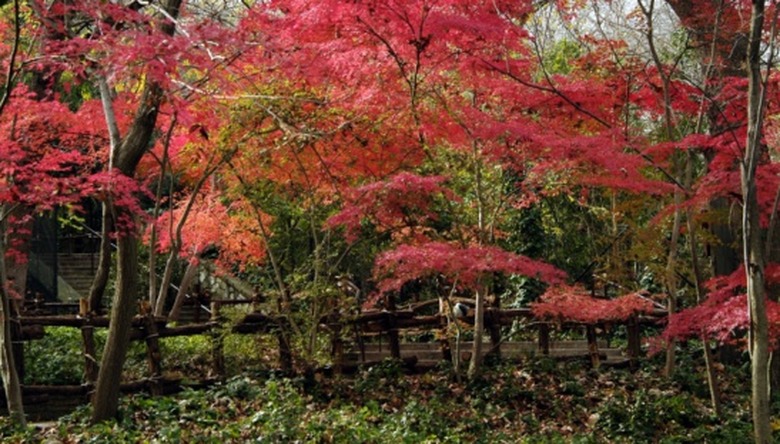Japanese Maple Companion Plants
The vibrant-colored spring and fall foliage of Japanese maples, along with their small size, makes them a prized landscape plant especially in urban gardens. The bright yellows, vibrant reds, maroons or chartreuse colors of the leaves, rather they are the regular maple tree shape or dissected, attract attention. The dissected leaves, which are fine textured and lacey, are referred to as "cut leaves" in the nursery trade. Japanese maples prefer growing in organic rich, moist soil in partial shade, although a few varieties tolerate full sun.
Grasses
Dwarf mondo grass, hakone and lirope are ornamental grasses that make perfect companions for Japanes maple because of their size and graceful appearance. Not all ornamental grasses are green, so when selecting on consider the color of the foliage of the Japanese maple, then select a grass that either contrasts with that foliage or is variegated. A variegated or light-colored grass makes the area under the Japanese maple brighter and draws attention. If the leaves on the Japanese maple are variegated, choose a plain green grass.
- The vibrant-colored spring and fall foliage of Japanese maples, along with their small size, makes them a prized landscape plant especially in urban gardens.
- Not all ornamental grasses are green, so when selecting on consider the color of the foliage of the Japanese maple, then select a grass that either contrasts with that foliage or is variegated.
Ground Covers
Ground covers serve several purposes in the garden and are ideal for growing under trees such as Japanese maples. They help block out weeds, conserve soil moisture and add color either with their foliage or their flowers — if they flower. Moss, ajuga, vinca, lemon thyme and woodland phlox look good grown in combination with Japanese maple trees. Moss is a little tricky to establish and does not thrive in many places, however if you have moss growing naturally in your garden, encouraging it to continue to grow is a great idea. Ajuga and vinca are rather aggressive plants, so consider this when selecting them as companions. Lemon thyme smells great and is edible. Woodland phlox adds a natural look to the garden and is a good nectar source for bees, butterflies and a variety of other insects.
- Ground covers serve several purposes in the garden and are ideal for growing under trees such as Japanese maples.
- Moss, ajuga, vinca, lemon thyme and woodland phlox look good grown in combination with Japanese maple trees.
Perennials
Hosta, daylily, lavender, santolina, Japanese painted fern, lungwort, heuchera and hellebore are all possible companions for Japanese maple trees. Consider the amount of sunlight the area under the tree will receive before selecting companions. Hellebore adds winter interest. Lavender adds fragrance. Some varieties of santolina have gray foliage, others have green. As with the ornamental grasses, consider the color of the Japanese maple foliage before selecting the variety of santolina to plant. Lungwort, hosta, heuchera and Japanese-painted fern are ideal for adding color.
- Hosta, daylily, lavender, santolina, Japanese painted fern, lungwort, heuchera and hellebore are all possible companions for Japanese maple trees.
- Lungwort, hosta, heuchera and Japanese-painted fern are ideal for adding color.
Evergreen And Woody Plants
Another option is to plant evergreen or woody plants as companions to Japanese maple trees. Dwarf blue juniper, rhododendron, azaleas, spirea and hydrangea are just a few of the options. Remember that as these plants grow they not only get taller, but wider as well, so leave adequate room for them to grow. Digging up an older, established plant is not fun and it is not always possible. Be sure to leave a little more room than what the plant tag calls for so that even once they are mature you can access the plants to prune them and complete other garden tasks. Consider the bloom time of the rhododendron, azalea, spirea and hydrangea as well as the flower colors. Select flower colors that either complement or contrast with the Japanese maple foliage.
- Another option is to plant evergreen or woody plants as companions to Japanese maple trees.
- Be sure to leave a little more room than what the plant tag calls for so that even once they are mature you can access the plants to prune them and complete other garden tasks.
